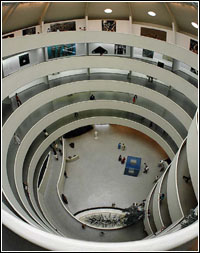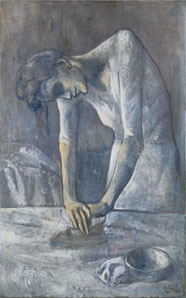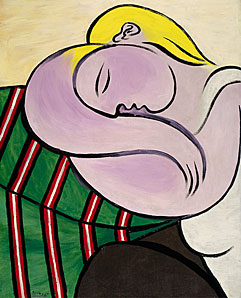Thanksgiving in New York: ogling the Guggenheim
I’m in New York for Thanksgiving, and yesterday I visited the Guggenheim.
The nice thing about the Guggenheim is that even when the exhibits are awful the Frank Lloyd Wright building is still fun:
And in this case the exhibit was exceedingly awful, a less disgusting but annoyingly vapid and coy version of the off-putting experience I wrote about here, in which the notion of art had pretty much degenerated into posturing and ironic messages.
This time, instead of cut-up cow body parts and elephant dung Madonnas, we had cowboys and Marlboro men, naughty nurse book covers, framed autographed photos of Hollywood stars and also-rans, and enormous single-color canvasses with Henny Youngman-type jokes marching across their centers in large black letters.
This is the work of Richard Prince, intended as some sort of wry postmodern commentary on America and its values; I think it’s mostly a sad commentary on the postmodern death of art. Fortunately, off to the side in the smaller and more conventionally-shaped galleries of the museum there was an exhibit of older art; containing a fair amount of Kandinsky, Chagall, and Picasso, as well as a few Cezannes and Gauguins and other painters of that era.
Compared to the abominations that filled the main downward-spiraling (in more ways than one) body of the museum, these works—once so scandalous and revolutionary themselves—represented a calm oasis, a return to painterly values such as color and form, harmony and light, and—dare I say it?—beauty. They seemed nearly as ancient and classic as the Parthenon, as accessible as Norman Rockwell.
Two familiar Picassos were there that I’d studied in college art history courses, although I’d never seen them in person before. Like many Picassos, they are exceedingly different in style from each other—indeed, if one didn’t know how protean Picasso was as a painter, one would swear they’d been created by two different artists.
One was entitled “Woman Ironing.” It’s from his blue period; a somber and nearly monochrome representation of a worn and weary woman hard at work:
The other was “Woman with Yellow Hair,” a portrait of one of Picasso’s myriad mistresses, full of sensual curves and rich glowing colors, languid and relaxed:
The two were not close together, but they were in the same gallery, and as I happened to glance from one to the other I could not help but notice what I’d never noticed before: the similarity of their poses, although the dramatically different works were painted nearly thirty years apart.
Just look at the sharp bend of the heads and the nearly horizontal angle of the profiles, and the way the left shoulder is emphasized. Despite the different feel and tone of each painting, there’s a leitmotif that runs through them and unites them. Perhaps it’s a certain proportion or grace that Picasso intuitively sensed—much like the Golden Ratio—without knowing how or why. Or perhaps he just likes the pose.
The catalog for the Prince exhibit was in the museum store, to the tune of sixty big ones. My advice is to save your money.




It’s pretty eerie! My husband and I saw the same Prince exhibition, hated it for the same reasons, and found ourselves drawn to the “Woman Ironing” as an antidote to its ugliness and vulgarity.
I just looked up Mr Prince on Wikipedia. It seems some of his pieces were “rephotographs” of pictures published in the NY Times. I believe that used to be called plagiarism in the olden days. As HL Mencken said: “Nobody went broke underestimating the intelligence of the American public.” In this case it’s a more narrow sample, the art world elite who have been fooled by a charlatan.
I have never cared for the place. I think it fails of its essential function. Because the ramp slopes, you cannot stand and contemplate an artifact until you understand it or are satisfied. You are continually being dragged away. Further, because of the ramps, you cannot back up to see something in a different perspective.
I’m in NYC for Thanksgiving too, and may end up visiting some art exhibitions with my wife (part of her job). I hate the fact that I dread these things, I want to find something to connect with in art (and maybe I will as you did, by taking a detour from the contemporary), but I’ve learned to expect snarky cynicism and derisive social commentary standing in for the pursuit of depth, technique, and (gasp) beauty, and sadly I haven’t seen any indication that art world attitudes are changing. If I can manage a detour of my own, I may seize the opportunity to pay a visit to lower Manhattan, to see for myself how things are or are not progressing there.
My (cynical) opinion is that “art” is all about exclusivity. The harder something is to relate to, or more off-putting it is, the more elite a person can feel for being among that elite crowd who understands “art”.
Art (without the scare quotes) ought to be about *connection* rather than exclusivity. Good art ought to touch the commonality of humanity.
On a panel about writing at a convention the young up-and-comer gave a nod to his mentors (it’s a fairly tight writing community in our town) and said that one of them had pointed out to him that if you’re writing to get a reaction from the reader (and all writing worth reading does) that writing something dark was the cop-out. The easiest reaction to get is offense or revulsion or even fear (he had published horror shorts and, frankly, very good ones) and now that he was writing a novel that was *not* horror, he was finding it difficult. (His novel is excellent, though in more than one volume and I’ve only read the first.)
The moral of the story being… it takes more talent to paint, or write, something inoffensive or pleasant that reaches us emotionally. It’s easier to shock and offend. It’s a cop-out and a sign of a lack of talent (though the person may be quite talented in… marketing!) to depend on ugliness to gain a reaction and on the snobbery of the elite to call what does *not* connect to the masses, art.
Of course while you enjoyed the Guggenheim building itself, Wright forced you to endure the entire exhibition. The ramp limits you to a linear experience, where you must see the exhibit from beginning to, in this case, the bitter end. He did you no favors. Frank may have been a better sculptor than Architect.
Oh, and on the subject of the current state of art- I once visited a little Picasso Museum in Lucerne. It was from a small private collection, mainly sketches and small works. I though most of the paintings were second rate, but the sketches showed the talent and skill at the fundamentals of art that Picasso had. I thought about all the Picasso imitators I had seen that produced such bad work, and realized that they likely never learned to do the basics with any degree of skill. They were trying to work in a way that played off of – even rejected the normal means of visualization without first gaining the proper understanding of what it was they were reacting to. A fatal flaw. Picasso could do what he did because he had already gained an intimate understanding of what he was reacting to and restructuring. Those poor imitators were merely trying to produce ‘shocking’ views of the world.
To be fair, I also think that we have an unfair tendency to look at the current art world and feel it fails relative to past eras. As that Picasso museum in Lucerne taught me, 90% of what any artist produces is pretty bad. Most of what they do is exercise to make that 10% (if you’re lucky) of good art. When we look at the past, we tend to only look at that 10% of good art, since we’ve long since forgotten about the other 90%. In the present, we can’t help but see more than the 10%, and as a result, may judge the era more harshly than it deserves. Of course, all that said, when I look at what many consider the best of the last few decades, I think perhaps the criticisms are valid.
At least I’ve heard from some that ideas of beauty and ‘painterly-ness’ have resurfaced as areas of exploration for young artists and students.